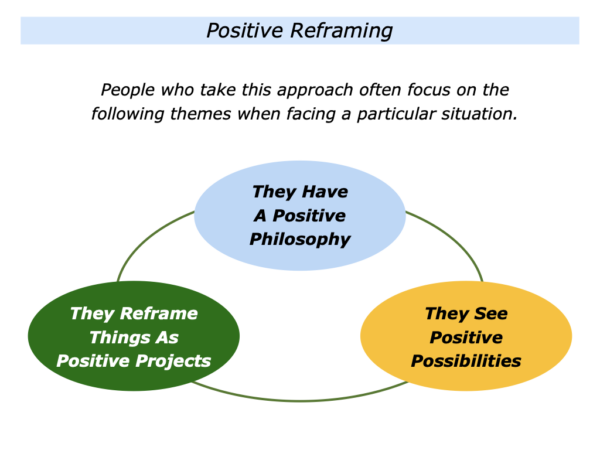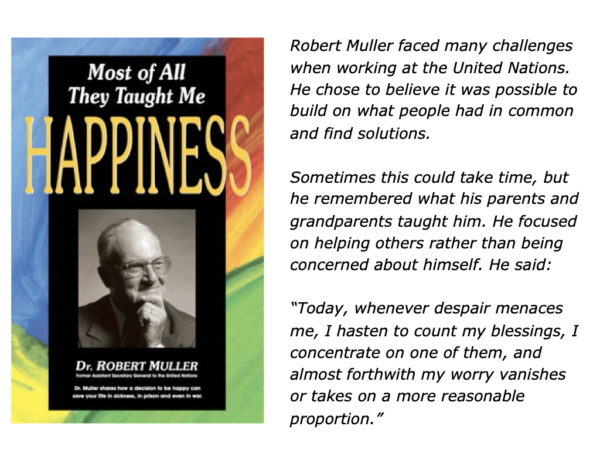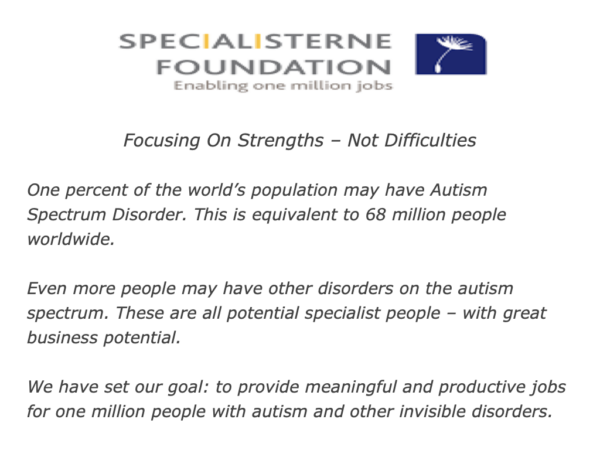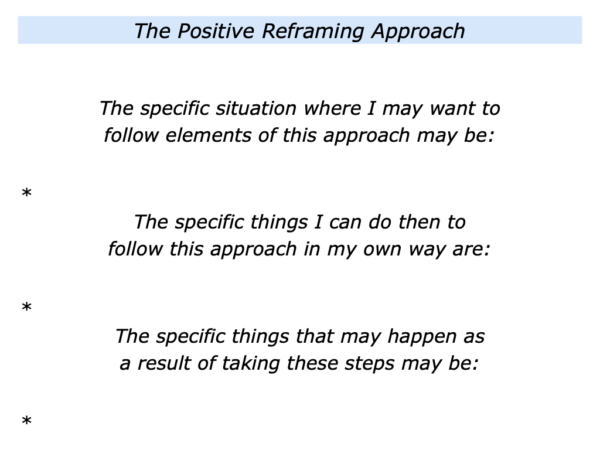
There are many ways to manage challenges. Some people take the positive reframing approach. They often demonstrate the following qualities.
They have a positive philosophy. They appreciate life and build on their assets. They then aim to do their best when facing a challenge or working towards a picture of success.
Such people see positive possibilities and solutions. They often study what works and apply it in certain situations. They also use their imagination to focus on the possible ways forward.
They sometimes manage their emotions by reframing things as positive projects. They may do this when tackling a challenge, embarking on a course of medical treatment or working to achieve a specific goal.
Different people follow these principles in different ways. Let’s look at how some have translated these into action.
They Have A
Positive Philosophy
People who take this approach are often positive realists. They have a positive attitude but are also good at reading reality. The following section describes how one person translated their positive philosophy into action in a frightening situation.
Robert Muller, an Assistant General Secretary of the United Nations, was somebody who took these steps. He reframed challenging situations as a chance to find creative solutions. Here is a summary of his approach.

Robert focused on the opportunities in many challenging situations. He adopted this approach as a student when he was hunted by the Nazis during the Second World War.
One day he found himself trapped in an attic on the top floor of an hotel that also served as an office building. Several Nazis entered the reception area and asked people where they could find Robert. How could he escape the hunters?
Drawing on his positive attitude to life, Robert began thinking of creative solutions. He explained his approach in the following way.
“I was a great fan of Hollywood films, so I decided to see the situation as taking part in a film. I was being hunted, so how could I find a way to escape?”
David Gillies takes up the story in his biography about Robert called The Hatmaker’s Son. Here are excerpts from David’s book.
Robert took several deep breaths.
“I must overcome my fear and think rationally,” he decided. This was the moment of moments to be creative.
“What an opportunity, what a tremendous adventure – a 20-year- old student trapped by Nazis in a fancy hotel. Won’t it be great if I slip through their fingers?”
Robert took a few minutes to consider his options. The Nazis had some idea what he looked like but they probably had an old photo. How could he take on a different persona?
The hunters were also expecting to find a cowering student trying to hide in the milling crowds on each floor of the building. How could he be ingenious and do what the Nazis least expected?
Robert settled on his plan and began translating it into action. This involved making his way down four floors from the attic and walking out onto the street.
Putting a thick file under his arm, he exuded an air of authority as he made his way from floor to floor. Nonchalantly smoking a cigarette, he passed various groups of people.
Reaching the ground floor he approached a group of Nazis who were quizzing the receptionist. She chose not to recognise him, even though she was being threatened.
Robert went up to the Nazis and asked what was happening. They replied they were looking for Louis Parizot (the name by which Robert was known in the building).
He responded by saying he had seen Parizot on the top floor. Just like in a film, the Nazis rushed up the stairs. Robert then made his way out onto the street and rode away on a bike.
Robert faced many challenges in life, but he tried to see things in perspective. During a time spent in prison he focused on how he could appreciate life and give to others.
Strongly influenced by his parents and grandparents, he aimed to help others and build a better world. He continued to apply this approach throughout his life.
Thankful for the love he had been given, Robert kept returning to this positive philosophy. Even in the darkest hours, he had a sense of gratitude. He then applied his skills to help people to build on what they had in common and find positive solutions.
They See
Positive Possibilities
People who take this approach look for possibilities and opportunities in situations. They study what works and apply these lessons to do what works. They also use their imagination to find solutions to challenges.
Thorkil Sonne is somebody who took this approach when founding the Specialist People Foundation. This aims to create one million jobs for people with autism.
Such people have many strengths. They often have outstanding memories, a remarkable eye for detail and do repetitive tasks with enthusiasm. These skills can be valuable for companies that specialise in developing technology.
The following section provides excerpts from the organisation’s website. This describes how Thorkil focused on pursuing the most positive option.

The Idea for Specialisterne and Specialist
People Foundation Started with Lars
My son Lars was 2½ years old when my wife and I noticed that his development began to differ from that of his older brothers.
We arranged with his nursery carers that he would get extra support from a qualified child psychologist, all the while hoping of course that we could learn how best to help him become more like his brothers.
Our Lives Changed
Eventually, we were informed that Lars had infantile autism – a life-long invisible handicap in the category of Autism Spectrum Disorder (ASD).
Lars would face a life where he would be constantly misunderstood and isolated because it would be difficult for him to interpret what others expected of him. Most likely, Lars would never have a normal working life.
My Fight
I became active in the Danish Autism Association. I also studied the Danish welfare model, and realized that although the model is strong and has many good aspects, there was a lot of room for improvement.
I learned that families with a child with ASD have a high risk of disintegration.
This is most often because this handicap is invisible, meaning that the family has to struggle to get the outside world to understand and provide timely support.
Social workers also work under difficult conditions where welfare schemes are available, but the knowledge of how best to help people with complicated invisible handicaps is thin on the ground.
I experienced that both those who need the help and those who provide help are under great and increasing strain.
Specialisterne
With the support of my family I re-mortgaged our home and established Specialisterne (The Specialists) in an attempt to tailor a working environment geared towards people with ASD, enabling them to use their specialist skills to act as consultants to the business sector, at market terms.
My vision is to create new possibilities for people with ASD and to influence society to adopt a more positive attitude towards people with ASD.
One Million Jobs
It is believed that one percent of the world’s population may have Autism Spectrum Disorder. This is equivalent to 68 million people worldwide.
Even more people may have other disorders on the autism spectrum, such as Attention Deficit Hyperactive Disorder (ADHD). These are all potential specialist people – with great business potential.
We have set our goal: to provide meaningful and productive jobs for one million people with autism and other invisible disorders.
Thorkil Sonne was elected as an Ashoka Fellow in 2009. Here is the citation that was published at the time.
Thorkil changes the way society perceives autism by transforming it from a handicap to a competitive advantage.
His Specialist People Foundation employs autistic people, who have a ten times lower fault rate in software testing and other tasks. Thorkil now plans to go beyond Denmark, empowering people with ASD globally.
They Reframe Things
As Positive Projects
People who take this approach sometimes manage their emotions by reframing things as positive projects. They may do this when tackling challenging situations.
This is an approach I learned about many years ago when reading about Ken Kesey. A leading figure in the counter-culture movement, he was said to have treated events as projects. One person reported that Ken even saw his approach to dying as a project.
This approach was helpful when I was fortunate to get an early diagnosis of prostate cancer. After a short while, it was possible to reframe it as a project. The aims were:
To do research and get the best non-invasive treatment … To produce a blog that helped other men to get such treatment … To continue to enjoy life and give to people.
Fortunately I was treated by some of the best surgeons in the world who did superb work and helped with the recovery. The blog also reached men who then chose to have non-invasive treatment. The journey also helped me to appreciate life and give to people. A good project.
Jack Sim is somebody who applied the project approach to achieving tangible goals. Taking a pride in being known as Mr. Toilet, he is committed to providing sustainable sanitation for people around the world.

Jack founded the World Toilet Organization. Here is some background about him and the organisation taken directly from its website.
Jack Sim, Mr. Toilet, has broken thetaboo on sanitation and brought issues about toilets and hygiene out into the open. After attaining financial independence as a businessman in Singapore by 40, Jack decided to devote the rest of his life to development work in line with his motto:
“Live a useful life.”
In 1998, Jack established the Restroom Association of Singapore (RAS) whose mission is to raise the standards of public toilets and address the issues of poor toilet design, inadequate building codes and poorly trained cleaners.
As Jack began his work, he realized there were organizations similar to this in other countries and without any central governing body.
Soon thereafter, he founded the World Toilet Organization (WTO) in 2001. Since 2001, Jack has been involved in sustainable sanitation efforts all over the world.
Let’s return to your own life and work. Looking ahead, can you think of a situation where you may want to follow elements of the positive reframing approach? How can you do this in your own way?
If you wish, try tackling the exercise on this theme. This invites you to complete the following sentences.







Leave a Reply